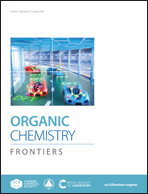Computational study of catalyst-controlled regiodivergent pathways in hydroboration of 1,3-dienes: mechanism and origin of regioselectivity†
Abstract
Metal-catalyzed hydroboration of 2-substituted 1,3-dienes is a straightforward and effective protocol for preparing synthetically versatile homoallylic boronates. However, controlling the regioselectivity of hydroboration remains a challenge. Hydroboration of 1,3-dienes with iridium and iron complexes as model catalysts gave 4,3- and 4,1-selectivity, respectively. To reveal the catalyst effects on regioselective control, density functional theory calculations were performed to systematically study their detailed mechanisms. Initially, the reactions with both catalysts proceed via a similar process, namely oxidative addition, to break the H–B(Bpin) bond. The different bonding and coordination natures of Ir and Fe then determine which of two reaction pathways is followed, and this determines the regioselectivity. The iridium catalyst favors 4,3-insertion of the 1,3-diene double bond into the Ir–H bond and this eventually leads to 4,3-selectivity. In contrast, iron, which is coordinatively unsaturated, favors 4,1-insertion of the 1,3-diene double bond into the Fe–H bond and this eventually selectively generates a 4,1-product.



 Please wait while we load your content...
Please wait while we load your content...